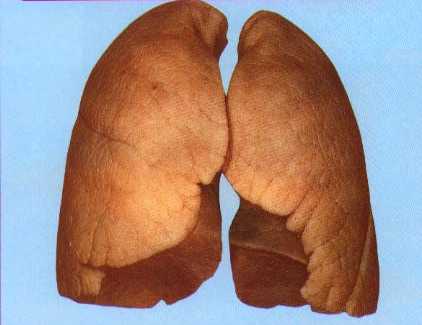
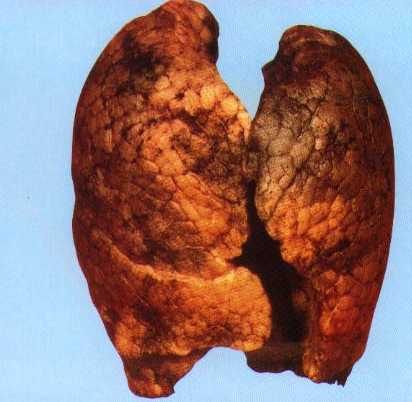
Cancer is a common and dreaded disease. About one third of Americans will die of cancer. It is often a lingering illness, becoming progressively more debilitating over years. For many forms of cancer, few of the afflicted are cured. We will do two sub-modules on cancer. Today, Cancer I, we will focus on cancer pathology, what is known scientifically about cancer. In Cancer II next week we will start on the consequences of what is known, and not known.
 |
 |
| Normal Lung | Smoker's Lung |
| From http://www.mii.kurume-u.ac.jp/~leuers/giveupsmoking.htm | |
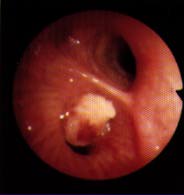 |
Here a photo of lung cancer blocking a bronchi (air tube in the lung). |
|
|
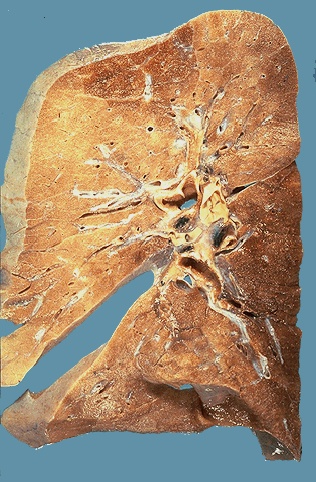 |
|
Section through cancerous lung http://www.nycenet.edu/csd16/webquest/singh/webquest.htm |
Section of Normal Lung. (http://www-medlib.med.utah.edu/WebPath/webpath.html#MENU) |
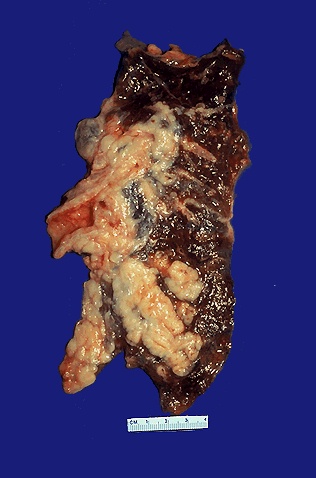 |
|
|
Another form of lung cancer. ((http://www-medlib.med.utah.edu/WebPath/webpath.html#MENU) |
Liver cancer. (The entire liver should look like the liver in the right half of the photo. ) From http://www.nycenet.edu/csd16/ |
What cancer is not:
Hypertrophy: an increase in tissue mass of an organ brought about by
an enlargement of its specialized cells, as in the muscle fibers (cells) of
a weight lifter. Hypertrophy = Bigger cells.
Hyperplasia: an increase in the functional tissue mass of an organ brought
about by an increase in number of the specialized cells, as in the uterus during
pregnancy. Hyperplasia = More cells.
Metaplasia: An adaptive and often reversible change from once cell type
to another. Chronic irritation of functional cells in the respiratory tract
replaced by nonfunctional skin-like cells. Metaplasia = Wrong cells.
What may be cancer, eventually
Dysplasia: disrupted cell development. Usually more cells and the wrong
cells.
What cancer is:
Neoplasia: a disorder in which there is a permanent and inherited change
in the cells resulting in a pathological proliferation of tissue which is excessive,
purposeless and autonomous, continuing indefinitely regardless of stimuli or
effects of the expanding neoplasm on the surrounding tissues. Put another way,
cancer is a disorder characterized by disruption of the normal homeostatic mechanisms
that regulate cell proliferation and cell death. A neoplasm may be benign
or malignant. Malignant neoplasms are able to invade tissues locally
and to spread to distant organs (metastasize).
Cancer is a common, generic term for a malignant neoplasm. ("Benign" neoplasms are not "good" at all; they may be fatal. Perhaps the name derives because they are usually considered "less bad" than a malignant neoplasm.)
A tumor is a swelling from any cause and not synonymous with cancer. Not all neoplasms result in a tumor, for example leukemia is a proliferation of the white blood cells, but is not a tumor.
The suffix"-oma" indicates a tumor, either benign or malignant. The suffix or word "-sarcoma" indicates a malignant tumor of the connective tissue, including blood vessels; the suffix or word "carcinoma" indicates a malignant tumor of the epithelial cells. But naming is not consistent. There are several hundred different clinical types of cancer.
The ToxTutor section, Cellular Toxicology, reviews a few things we have been learning and then has a good exposition on cancer. The Tutor uses a few different terms than I do, but not a problem.
(From: http://www.qub.ac.uk/cm/pat/education/Disorder/index.htm)